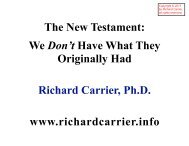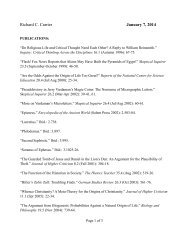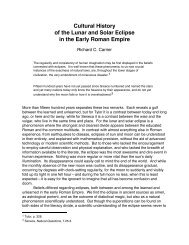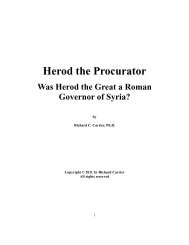“Bayes' Theorem for Beginners: Formal Logic and ... - Richard Carrier
“Bayes' Theorem for Beginners: Formal Logic and ... - Richard Carrier
“Bayes' Theorem for Beginners: Formal Logic and ... - Richard Carrier
Create successful ePaper yourself
Turn your PDF publications into a flip-book with our unique Google optimized e-Paper software.
0.5 x 0.1296 0.0648 0.0648<br />
P(h|e.b) = __________________________ = _______________ = _________<br />
P(h|e.b) = 0.835 = 84%<br />
[ 0.5 x 0.1296 ] + [ 0.5 x 0.0256 ] 0.0648 + 0.0128 0.0776<br />
RESULT: The more evidence you have, the higher the probability of the hypothesis,<br />
exactly as common sense would expect.<br />
5. Bayes’ <strong>Theorem</strong> has been proven <strong>for</strong>mally valid. Any argument that violates a valid<br />
<strong>for</strong>m of argument is itself invalid. There<strong>for</strong>e any argument that violates Bayes’ <strong>Theorem</strong><br />
is invalid. All valid historical arguments are described by Bayes’ <strong>Theorem</strong>. There<strong>for</strong>e any<br />
historical argument that cannot be described by a correct application of Bayes’ <strong>Theorem</strong><br />
is invalid. There<strong>for</strong>e Bayes’ <strong>Theorem</strong> is a good method of testing any historical argument<br />
<strong>for</strong> validity.<br />
6. You can use Bayesian reasoning without attempting any math (see below), but the<br />
math keeps you honest, <strong>and</strong> it <strong>for</strong>ces you to ask the right questions, to test your<br />
assumptions <strong>and</strong> intuitions, <strong>and</strong> to actually give relative weights to hypotheses <strong>and</strong><br />
evidence that are not all equally likely. But above all, using Bayes’ <strong>Theorem</strong> exposes all<br />
our assumptions to examination <strong>and</strong> criticism, <strong>and</strong> thus allows progress to be made, as<br />
we continually revise our arguments in light of the flaws detected in our reasoning.<br />
12. Avoiding Common Errors with Bayes’ <strong>Theorem</strong><br />
1. The Fallacy of False Precision.<br />
One common objection to using Bayes’ <strong>Theorem</strong> in history is that Bayes’ is a<br />
model of mathematical precision in a field that has nothing of the kind. This<br />
precision of the math can create the illusion of precision in the estimates <strong>and</strong><br />
results. But as long as you do not make this mistake, it will not affect your results.<br />
The correct procedure is to choose values <strong>for</strong> the terms in the equation that<br />
are at the limit of what you can reasonably believe them to be, to reflect a wide<br />
margin of error, thus ensuring a high confidence level (producing an argument a<br />
<strong>for</strong>tiori), regardless of any inexactness in your estimations.<br />
For example, surely more than 60% of major cities in antiquity had public<br />
libraries (the evidence is compellingly in favor of a much higher percentage,<br />
provided ‘major city’ is reasonably defined). But since we don’t have exact<br />
statistics, we can say that the percentage of such cities must fall between 60% <strong>and</strong><br />
100% (= 80% with a margin of error +/-20%). With such a wide margin of error,<br />
our confidence level remains high (see appendix). We are in effect saying that we<br />
might not be sure it was 100% (or 90% or even 80%), even though we may<br />
20








